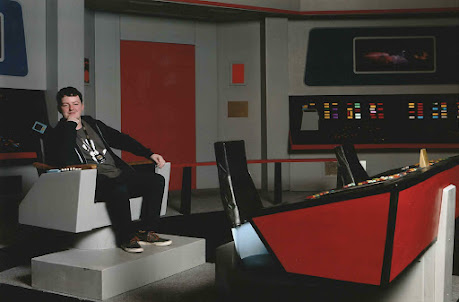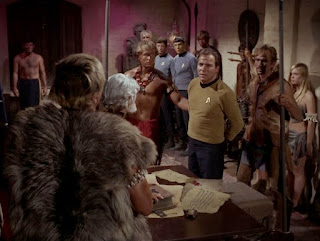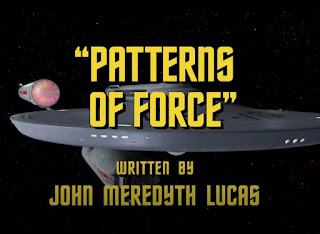Dame Agatha Christie may not be the most obvious person to link to Star Trek but her fingerprints can be found all over it (pardon the pun). Many tropes of the mystery genre have their roots in her works, along with Arthur Conan Doyle’s iconic Sherlock Holmes who is referenced again and again in the Trekverse. Locked-room mysteries, many-layered puzzles, red-herring clues and more. From the classic whodunit plots to the rules of her novels to the actors who have appeared in adaptations of her work, lets take a look at how the Queen of Crimes work parallels some classic Trek tropes.
THE UNUSUAL SUSPECTS
Looking over the casting of both big and small-screen adaptations of Christie reads like a who’s who of the acting world. Certainly for British actors appearing as either a victim, killer or suspect in one of her stories is almost a rite of passage. Here are some names you may recognise and the stories they appeared in
ACTOR | Trek Appearance(s) | Christie Adaptation |
Michelle Yeoh | Disco / Section 31 | A Haunting in Venice |
Alexander Siddig | DS9 | Cards on the Table |
Alice Eve | Into Darkness | The Mystery of the Blue Train / Ordeal by Innocence |
Orla Brady | Picard | The Labours of Hercules |
David Warner | TNG, ST6 | 4.50 from Paddington |
Dame Joan Collins | TOS | They Do it with Mirrors |
Benedict Cumberbatch | Into Darkness | Murder is Easy |
Harry Treadaway | Picard | Sleeping Murder |
Kim Cattrall | ST6 | Witness for the Prosecution |
Ella Purnell | Prodigy | Ordeal by Innocence |
Ed Speleers | Picard | N or M? |
Alice Krige | First Contact, VOY | The Secret Adversary |
RULES OF THE GAME
There are a lot of elements that a great mystery needs in any genre. A protagonist we want to succeed in the solving, a group of viable suspects with their own unique motivations and a big reveal at the end to name a few. The Star Trek universe expands on these in interesting ways. Our protagonists tend to be our series regulars who solve mysteries based on their specialist areas, the suspects and culprits can extend to the realm of alien or supernatural and the reveal can be just one part of a wider ongoing story. However the essential ingredients are the same. There are rules to be followed. The examples in Trek are too many to count but some episodes stand out above the rest when it comes to having their roots in Christie’s tropes
The worlds of Hercule Poirot and Jane Marple could not be further removed from Star Trek if they tried. Only on the holodeck will you find an imposing manor house (a la Janeway’s gothic romance novel) or a quaint little village (a la Fair Haven) with a dark underbelly. That being said the general plots one imagines of a Christie novel (unscrupulous character gets offed, anyone could have done it, the detective uncovers the truth and reveals it in some dramatic fashion) inspire some terrific Trek episodes.
WHODUNIT?
TNG’s ‘Suspicions’ sees Beverly Crusher at the centre of a murder mystery when a group of scientists board the Enterprise, only for one of them to wind up dead. Crusher ‘interviews the suspects’ as she believes something is not quite right. She then proceeds to work out the truth based on her deductions. A notable Christie trope is the investigator setting a trap for the culprit which will potentially put themselves or others in danger. The Miss Marple classic ‘The Moving Finger’ sees one character submit to being drugged by the perpetrator in order to allow the police to swoop in at the last minute to apprehend the killer. Here, Crusher puts her career on the line by performing an illegal autopsy then literally flies into a star to prove that Jo’Bril’s theories were correct seemingly with no thought for her own safety. The twist ending where the victim has been alive the whole time is ingenious. Agatha Christie is a grandmaster of twist endings, most notably in ‘The Murder of Roger Ackroyd’, and the literary phenomenon that is ‘Murder on the Orient Express’ along with the superb standalone ‘Endless Night’.
NEVER TRUST AN ACTOR
Whenever one is reading a Christie novel and an actor turns up it’s usually a sign of something suspicious going on. ‘Lord Edgware Dies’, ‘Three Act Tragedy’ and ‘The Mirror Crack’d from Side to Side’ are just a few examples of characters with a theatrical background forming part of the narrative, occasionally as the culprit or victim or simply posing as someone else with ulterior motives. ‘The Conscience of the King’ is an underrated gem from TOS’ first season which gave us our first proper Trek whodunit as a group of actors board the Enterprise . While perhaps not being a whodunit in the traditional sense, the mystery of the true identity of Anton Karidian / Kodos the Executioner along with the twist of his daughter as the killer has echoes of Agatha Christie. The iconic ‘Murder on the Orient Express’ features an entire cohort of suspects each playing a different role to exact revenge on a notorious killer now living out his later years under an assumed identity. Sound familiar?
DIFFERENT PERSPECTIVES
More than one entry in the Christie oeuvre involves the detective piecing together events that happened many years ago and finally unmasking the killer. There’s a couple of parallels with Star Trek episodes to highlight here. Firstly, TNG’s A Matter of Perspective plays like a version of the Poirot story ‘Five Little Pigs’. In the novel we see Poirot meet and interview 5 witnesses to the death of artist Amyas Crale with each offering their own recollection of the events of years ago. The TNG episode has one of the best uses of the holodeck we’ve seen as Riker finds himself arrested on suspicion of murdering renowned scientist Dr. Apgar. We are treated to a series of holo-simulations of the events leading up to the death, each from the viewpoint of a different witness. All of this culminates in the truth ultimately being exposed as the investigators make sense of the conflicting versions of events.
LOOKING BACK TO MOVE FORWARDS
Revisiting past events to discover the truth behind a crime also appears in both Christie and Trek. The underrated DS9 episode /noir homage ‘Necessary Evil’ sees Odo having to re-open an investigation into the death of a Bajoran collaborator during the Cardassian Occupation. The twist here is that the culprit (Kira) at this point is a close friend of the detective (Odo). One of Christie’s best and most famous novels (which I won’t name here for spoiler reasons) also involves a close confidant of the detective throughout the investigation ultimately being unmasked as the killer in a shocking final act twist.
DRAWING ROOM DENOUEMENT
While it doesn’t happen as often as the many TV adaptations would have you believe, the stereotypical ending to a Poirot or a Marple involves them gathering all the suspects in one location and laying out the entire scheme of the murderer(s). It’s a device that’s used in some of her finest works including 3 of my personal favourites ‘Death on the Nile’, ‘A Murder is Announced’ and the underrated ‘Peril at End House’. When it comes to Star Trek one of the most obvious examples of this trope is the ending of Voyager’s ‘Ex Post Facto’ which finds Tom Paris accused of a murder he didn’t commit. Thanks to the deductive skills of Tuvok, he is able to expose the culprit in the victim’s living room, exonerating Tom. We even get a dog as a key witness a la Bob the terrier in the Poirot mystery ‘Dumb Witness’
SUMMING UP THE CASE
Dame Agatha is one of the greatest writers who ever lived. Her impact stretches far and wide over popular culture. All of this is based on my own interpretations of episodes and the tropes involved but the influence of her work (intentional or not) cannot be ignored. While she may not have created the mystery genre there is no-one who can match her for set-ups, characters and twist endings that even the most attentive reader won’t see coming. Over a length of time comparable to her career, incredibly talented writers have brought the different versions of Star Trek to our screens. The format lends itself to almost any genre, horror one week, comedy the next, followed by a rollicking action-adventure or a courtroom drama. Some of the real standouts though are when Trek tackles a good old fashioned mystery. Follow the clues, find the culprit and on to the next case. Every writer who attempts to pen a mystery is following in Christie’s footsteps, and Trek does it brilliantly
ON FURTHER INVESTIGATION
Other Trek entries that fall into the ‘Christie mystery’ category include but are not limited to:
TOS - Court Martial, Journey to Babel, Wolf in the Fold
TNG - Allegiance, Clues, The Chase
DS9 - The Collaborator, Improbable Cause, Field of Fire
VOY - Rise, Retrospect, Inside Man
MOVIES - The Undiscovered Country










